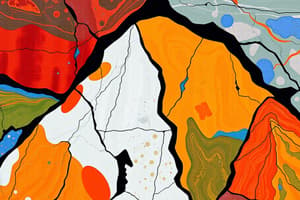Podcast
Questions and Answers
What is the primary driver of regional metamorphism?
What is the primary driver of regional metamorphism?
- High temperatures near a body of magma
- High differential stress along fault zones
- Intense pressures from deep burial along continental-continental convergent zones (correct)
- Rapid uplift and decompression of rocks
What is the primary driver of dynamic metamorphism?
What is the primary driver of dynamic metamorphism?
- Rapid uplift and decompression of rocks
- High temperatures near a body of magma
- Intense pressures from deep burial along continental-continental convergent zones
- High differential stress along fault zones (correct)
Which of the following is NOT a common location for contact metamorphism to occur?
Which of the following is NOT a common location for contact metamorphism to occur?
- Plutons
- Subduction zones
- Mid-ocean ridges (correct)
- Hotspots
What is the term for the original rock from which a metamorphic rock is formed?
What is the term for the original rock from which a metamorphic rock is formed?
What is the term for the process of minerals within a rock changing shape and structure due to the high pressures and temperatures of metamorphism?
What is the term for the process of minerals within a rock changing shape and structure due to the high pressures and temperatures of metamorphism?
What is the term for the process of metamorphism that occurs when pressure and temperature are relieved?
What is the term for the process of metamorphism that occurs when pressure and temperature are relieved?
What is the term used to describe a group of characteristic minerals in a metamorphic rock?
What is the term used to describe a group of characteristic minerals in a metamorphic rock?
How does the geothermal gradient of a rock depend on its formation environment?
How does the geothermal gradient of a rock depend on its formation environment?
What is the dehydration reaction of pyrophyllite (Al₂Si₄O₁₀(OH)₂) during metamorphism?
What is the dehydration reaction of pyrophyllite (Al₂Si₄O₁₀(OH)₂) during metamorphism?
Which metamorphic environment is most closely associated with the pressure-temperature-time (P-T-t) path shown in the blue region of the phase diagram?
Which metamorphic environment is most closely associated with the pressure-temperature-time (P-T-t) path shown in the blue region of the phase diagram?
What is the purpose of identifying the minerals present in a metamorphic rock?
What is the purpose of identifying the minerals present in a metamorphic rock?
What is the relationship between the stability fields of kyanite, andalusite, and sillimanite, as shown in the phase diagram?
What is the relationship between the stability fields of kyanite, andalusite, and sillimanite, as shown in the phase diagram?
What is the term used to describe metamorphic rocks that have undergone significant partial melting?
What is the term used to describe metamorphic rocks that have undergone significant partial melting?
Which of the following features is NOT associated with foliated metamorphic rocks?
Which of the following features is NOT associated with foliated metamorphic rocks?
What is the term used to describe the pattern formed by alternating layers of minerals aligned perpendicular to the direction of stress in metamorphic rocks?
What is the term used to describe the pattern formed by alternating layers of minerals aligned perpendicular to the direction of stress in metamorphic rocks?
In the progression of metamorphism for a typical shale protolith, what is the correct order of metamorphic facies?
In the progression of metamorphism for a typical shale protolith, what is the correct order of metamorphic facies?
Which of the following statements about metamorphic rocks is NOT true?
Which of the following statements about metamorphic rocks is NOT true?
What is the primary reason for the recrystallization of minerals in metamorphic rocks?
What is the primary reason for the recrystallization of minerals in metamorphic rocks?
Flashcards are hidden until you start studying
Study Notes
Formation of Metamorphic Rocks
- Metamorphic rocks form through regional, dynamic, and contact metamorphism
- Regional metamorphism occurs due to intense pressures from deep burial, typically along continental-continental convergent orogenic zones
- Dynamic metamorphism occurs due to high differential stress, typically along fault zones
- Contact metamorphism occurs due to high temperatures, typically next to a body of magma, along subduction zones, hotspots, and next to plutons
Characteristics of Metamorphic Rocks
- Metamorphic rocks can form from any other rock type
- The original rock is called the protolith
- Normal metamorphism is called prograde metamorphism, while reversal of the process is called retrograde metamorphism
- High pressures and temperatures cause minerals to change shape and structure through recrystallization
- Minerals can be identified to determine the conditions under which the rock formed
Features of Metamorphic Rocks
- Facies are groups of characteristic minerals that form under specific conditions
- Rocks follow a predictable geothermal gradient with increasing depth based on their formation gradient
- Foliation forms when minerals align perpendicular to the direction of stress, creating a layered structure
- Foliation can disappear due to recrystallization of micas
- Non-foliated rocks lack micaceous minerals and typical foliation patterns
- Compression of rocks removes pores and sedimentary structures like fossils
Metamorphic Facies
- Temperature and pressure increase during metamorphism, leading to a progression of metamorphic rocks
- Example progression: shale → slate → phyllite → schist → gneiss
- Certain conditions predictably create the same sets of characteristic minerals
Studying That Suits You
Use AI to generate personalized quizzes and flashcards to suit your learning preferences.




